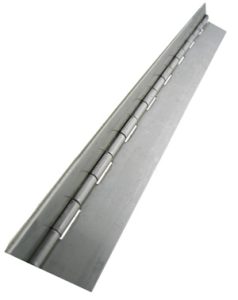
You can’t ignore the gauge when shopping for a hinge. Hinges are mechanical bearings that allow for a limited degree of rotation. They are commonly used on doors, gates, cabinets and access panels. Once installed, hinges will allow objects such as these to swing open. The gauge, however, is a small but important specification to consider when choosing a hinge.
What Is Hinge Gauge?
The term “gauge” is used to describe the thickness of a hinge’s leafs. The higher the gauge, the thicker the hinge’s leafs.
While there are many different types of hinges, most of them feature a similar design consisting of two leafs and a pin-secured knuckle. The leafs are the rectangular-shaped panels on the side. The knuckle is the center of a hinge that’s formed when the two leafs are pressed together and interlocked. A rod-like pin is inserted into the hollow center of the knuckle so that the leafs won’t separate. The gauge is simply the thickness of the two leafs.
A standard 3 inch by 3 inch door hinge may have a gauge of 0.079 inches. In other words, the width of a door hinge’s two leafs is just under one-eighth of an inch.
Why Hinge Gauge Is Important
Because they are designed to hold two objects together — a door to an adjacent frame, a gate to a fence, etc. — hinges must be strong. Weak hinges may buckle under the weight of the objects with which they are used, resulting in failure. High-gauge hinges are typically stronger than low-gauge hinges, so they are less likely to fail.
With thick leafs, hinges are able to support more weight. They can hold heavier doors, gates and panels than hinges with thinner leafs. For applications involving heavy doors or objects, you’ll need to choose high-gauge hinges.
Proper alignment requires choosing hinges with an appropriate gauge. If the gauge is too light, the hinges may warp. As you open and close the door, for instance, the hinges may scrape or stick. Misalignment such as this will cause premature wear and tear than shortens the lifespan of the door.
In Conclusion
Hinges are available in different sizes. Some of them are long, whereas others are short. Some hinges also have thick leafs, whereas others have thin leafs. You can identify the thickness of a hinge’s leafs by checking the gauge. High-gauge hinges have thicker leafs with a higher weight capacity than low-gauge hinges.
